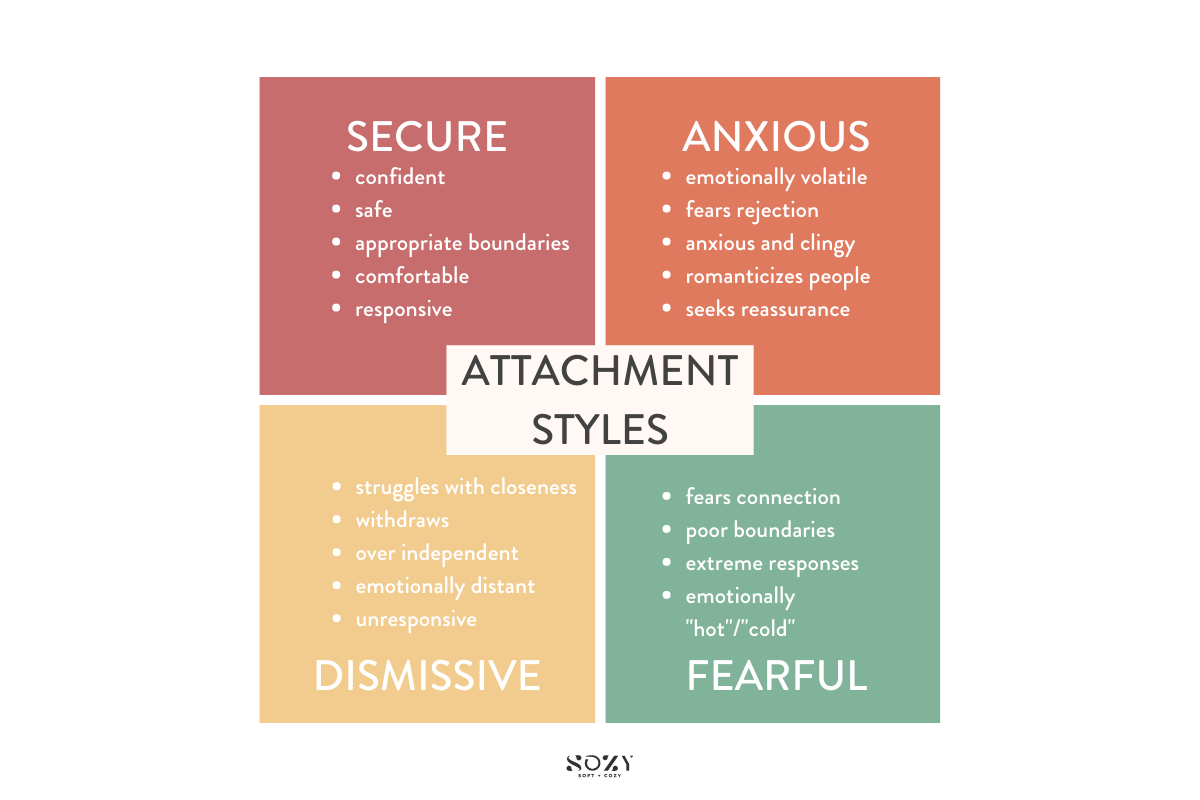
You've been dating someone for a month now and you're waking up next to them for the first time. You're anticipating a slow morning with them and spending the whole day together, but the moment they wake up, they're rushing out of your bed.
What gives?
You're laying there still high on emotions from last nights' soiree, meanwhile, your Hinge match is looking for their shoes. They mumble on about how last night was fun but they aren't giving off the vibe like they want to stay for coffee.
After they leave, you're suddenly questioning everything, "Did I read this all wrong?" "Are they no longer interested in me?" "Will they text me? Should I text them?".
Your head is spinning. They are avoiding getting "too close" while you're feeling rejected.
This push-pull dynamic is all too common in the dating world today, and your attachment style may be able to explain why.
What is Attachment Theory?
Attachment theory proposes that all humans are born with a need to bond to their primary caregiver. This bond can begin as early as inside the womb and how we form our attachment dictates how we may form our adult relationships.
John Bowlby, Father of Attachment Theory
Attachment Theory was first developed by psychoanalyst John Bowlby while researching the intense distress that infants undergo when separated from a parent. Bowlby theorized that attachment behaviors such as crying, clinging, and searching, were adaptive responses triggered by separation.
Because we, as humans, cannot simply feed and protect ourselves in infancy, we rely solely on our caregivers for survival. This means any bit of separation from our only source of food and protection feels extremely threatening to our survival.
Bowlby often looked through an evolutionary lens to explore how our attachment bonds have developed and played out over time. He uncovered what was coined as The Attachment Behavioral System that simply refers to how children emotionally regulate through the proximity of their primary caregiver.
If a child feels that their parent is nearby, within reach, and emotionally available, they will then feel safe, secure, and confident to be independent and play with other children.
On the contrary, if they feel that their parent is emotionally or physically inaccessible or non-attentive, they will likely begin to experience anxiety, visibly search for their parent or call out for them.
These behaviors continue until either they regain emotional or physical proximity or they shut down. In this case, children can experience both grief and despair.
Mary Ainsworth’s “Strange Situation”
Following his initial findings, John Bowlby's student and developmental psychologist, Mary Ainsworth, led an experiment to further explore the individual differences in attachment patterns.
Ainsworth and her students developed a process called The Strange Situation- a laboratory study that explored child development patterns and behaviors at one year of age and the responses they exhibited to their primary caregivers. In The Strange Situation, infants would be intentionally separated from and reunited with their primary caregiver.
In this study, about 60% of children showed signs of distress when the parent would leave the room, but once they returned, the child would actively seek out for them and easily be soothed by them. These children were thought to have a secure attachment.
In the same study, about 10-15% showed the same signs of distress when mom would leave, but exhibited extreme resistance and inability to soothe or calm down once the parent would return. These infants had an anxious preoccupied attachment style.
The third pattern of attachment that made 20% of infants is called avoidant attachment. These children would show little care when mom would leave, almost like they were ignoring their absence. Upon their return, the child would continue to play with toys or focus their attention elsewhere and actively avoid reaching out to their parent.
The final and least common attachment pattern is referred to as fearful-avoidant or disorganized attachment which makes up roughly 5-10% of children. For this attachment pattern, the child has a very inconsistent way of coping. They may seek for their parent then avoid them, or completely freeze and fall.
Mary's work in the Strange Situation was extremely important given that her research was the first to organize the attachment patterns into different styles. According to her findings, there are four attachment styles: secure, anxious, avoidant, and fearful/disorganized.
The 4 Different Types of Attachment Styles

In childhood, the way in which we attach or bond to others is entirely based on our parents' ability to attune to (respond and connect to) our emotional, psychological, and physical needs. This human phenomenon explains that our primary caregivers' responsiveness, emotional availability, and even physical proximity build the foundation for our experience of love and connection.
Since how we received love as children can be wildly different than how others received love, our human attachment styles differ from one another as well.
Secure Attachment
Remember the scenario we visited earlier? Waking up next to a new fling only to be confused as to why they rushed out in such a hurry? Let's rewind the story for a minute and explore what might have happened with a secure attachment.
With a secure attachment style, two newly-dating individuals might feel more inclined to continue connecting after their first intimate experience with each other (rather than rushing out the door). Both people may be more comfortable sharing how they feel about each other, without worrying as to whether they are "good enough" for the other person. Additionally, each person would likely remain confident in themselves and the relationship, even if one person, for example, doesn't send a follow-up text later in the day.

As we know, our ability to develop a secure attachment style relies mainly on our parents' attentiveness to us. When we are secure, our primary caregivers are most often responsive to our needs, remain emotionally available, and connect with or nurture us amply and consistently.
Their parenting style oftentimes stem from a strong sense of self-awareness and secure adult attachment styles. Their consistency empowers us to feel confident in our independence, safe to connect with others, and build stable mental health. These secure characteristics vary, however, between childhood and adulthood and can look like:
Characteristics as Children
- Mild to moderately upset when a parent or caregiver is not present
- Seeks parent when they return
- Can be easily soothed and comforted by a parent
- Easily expresses emotions with parents
- Experiences healthy boundaries with caregivers
Characteristics as Adults
- Feels confident in their relationships
- Being close with a partner feels safe
- Appropriate boundaries in relationships
- Feels comfortable on their own
- Can vulnerably express emotions to loved ones
- Strong self-esteem
Insecure Anxious Preoccupied Attachment
We know that when we are consistently attuned to by our parents in early childhood, a secure attachment is likely to develop. But what happens when the emotional attunement, love, and availability are inconsistent? This is the anxious attachment style.
Those that form an anxious attachment style (also known as anxious preoccupied) often had a parent who provided ample love, care, and attunement.
However, for some, this love and care could have been overbearing or extreme and very inconsistent. This leaves us to feel anxious as to whether our primary caregiver will be there for us or not, oftentimes forming a fear of abandonment, rejection, or betrayal.

In addition, some might experience a lack of healthy boundaries with a parent, like venting about their financial struggles or marital issues, changing their mind all the time when it comes to decisions or punishment, or being anxious themselves and always worried.
Those of us who develop this attachment style have common fears in both childhood and adult relationships and the characteristics share many similarities.
Characteristics as Children
- Separation anxiety when the parent leaves
- Not easily consoled when the parent returns
- Lack of boundaries with parents
- Tendency to throw tantrums and sudden rages when not getting their way
- Does not feel safe on their own
Characteristics as Adults
- Fear of rejection, abandonment, betrayal by loved ones
- Anxiety and clinginess within relationships
- Mood swings and difficulty regulating emotions
- Quickly romanticizes people and situations
- Seeks closeness, reassurance, and emotional availability
Insecure Dismissive Avoidant Attachment
The second insecure attachment style is called avoidant. People who develop the dismissive-avoidant attachment style tend to have had parents who were often emotionally or physically unavailable.
Perhaps mom was preoccupied with another child who had a disability or health issue. Maybe one or both parents showed no emotion at all and vulnerability was not welcomed or explored. When we develop an avoidant attachment style, the most common inner narrative is "I cannot depend on others". This inner story usually stems from the experience of needing to be attuned to as a child, but not receiving the attention and connection that was desired.

Naturally, when we learn that our needs will often go unmet, we learn to be more independent. There often lies a fear within avoidant types that "getting too close to others is not safe" because the closeness that we needed and did not receive becomes unfamiliar and therefore perceived as unsafe.
People that develop the dismissive-avoidant attachment style also share commonalities in the behaviors they exhibit in both childhood and adulthood. However, the key characteristic is simply, avoidance.
Characteristics as Children
- Does not seek connection with the parent often
- Independent behavior and seem unbothered by parents' absence
- May run away from the parent or avoid eye contact
- Easily distracted by the environment
Characteristics as Adults
- Struggles with closeness and intimacy in relationships
- Dismissive in their responses and withdraws from confrontation
- Ultra independent, craves freedom
- Emotionally distant, avoids vulnerability
Fearful Avoidant (Disorganized) Attachment
The final attachment type is called the fearful avoidant attachment style. This attachment system, also referred to as the disorganized attachment style, is the most complex of the four attachment styles and is often a result of developmental trauma.
People that develop this attachment tend to have very mixed emotions, dissociative tendencies and can exhibit characteristics from the other insecure attachment styles.
A fearful/disorganized attachment develops when our primary caregiver- the only source of safety - becomes a source of fear. Unlike the securely attached, disorganized individuals often experience a parent or caregiver who responded inappropriately or violently.
If our attachment figure is emotionally or physically abusive, unsafe, or mentally unwell, our ability to process and regulate emotions becomes disrupted. The desire for connection becomes blocked by the fear of being hurt, resulting in a very confusing emotional experience. Some of the characteristics associated with this attachment are:
Characteristics as Children
- Inability to self regulate emotions
- Resistant and/or avoidant towards the parent
- Dazed, dissociated, or confused
- Seeks closeness from the parent then resists
Characteristics as Adults
- Fears emotional connection and intimacy in relationships
- Little understanding of healthy boundaries
- Extreme rage or anger responses
- Emotionally "hot/cold" or dissociative
How These Attachment Types Affect Your Relationships
While the attachment styles we develop are a result of our childhood experiences with our primary caregivers, the characteristics, fears, and insecurities can stay with us in our adult relationships. These adult attachment tendencies are shown to us more often than we realize, and have become normalized among the dating culture.
Remember Ross Geller from Friends? If you were a fan of the popular 90's show, you know that for the majority of the series Ross and Rachel were an on again off again couple who couldn't seem to make up their mind about being with one another. Ross constantly questioned whether he was good enough for Rachel.

He would easily get jealous of men in her life (like that one coworker, Mark), and overthink every detail of their relationship. Ross was a clear example of the anxious attachment type. As we know with most anxious types, the fear of being rejected and/or abandoned runs deep.
This means that in any close relationship, anxious attachers can easily be triggered to question their self-worth, especially when the partner on the other side is an avoidant individual.
When looking at attachment styles in relationships, a common experience that couples face is called a push-pull dynamic. When an avoidant partner reaches for more space, and less intimacy, the anxious partner reaches for more emotional closeness and reassurance.
The more frequently we want to push partners away when we're avoidant, the more intensely we pull our partners in for connection when we're anxious. This leaves us in a perpetual cycle of push-pull.
For avoidant attachers, getting too close to a partner, physically or emotionally, feels like a trap. Being in an intimate relationship often stirs up a lot of resistance.
How many times have you heard someone say "The minute people get close, I run away! I always mess up a good thing." or "I can't do relationships, I want space, freedom, and independence. Being committed to someone ties me down." These are hallmark signs of avoidant attachment behavior.
Although the anxious-avoidant dance is common in a romantic relationship, secure relationships are not so rare. If you've ever watched the tv comedy show, The Office, you may remember Jim and Pam. While this couple didn't exactly exhibit the cuteness overload we see in some relationships, they showed little to no concern as to whether they were "good enough" for one another or if they were getting "too close".

For this relationship, it was clear that the two of them were securely attached. When partners develop a secure attachment style, each person feels safe to explore emotional intimacy, lean on one another for support, are self-sufficient and interdependent, and showcase their love for one another in healthy ways. With a secure partner, emotional needs are met with ease, but there is always room for growth.
Being in a securely attached relationship does not mean arguments, disappointment, mistakes, and even insecurities will never arise. It means that having an open and honest connection acts as the foundation for relationship success. In short, a secure relationship is a healthy relationship.
While our adult attachment style plays a huge role in our relationship with ourselves and others, it is possible to reclaim security. The first step is awareness. Becoming aware of our patterns, our attachment tendencies (which you can determine through a quiz like this one), and ultimately our fears around love, can better equip us to move closer and closer towards building healthy, happy, and secure relationships.

About The Author | Alexa Florentina
Trauma Informed Practitioner, Embodiment Coach and Writer. Rooted in compassion and self- belonging, Alexa coaches/writes from a trauma informed lens to support ambitious individuals struggling through shame, pain and limiting patterns to find their truth and return home to themselves. She guides men, women and entrepreneurs in reclaiming sovereign lives and reigniting their own inner medicine so they can live and lead purposefully. Alexa incorporates Poly Vagal Theory, Intergenerational Trauma, Somatic Experiencing, and Attachment Theory in her work with clients.
Follow her work and join her programs by signing up for her newsletter or connecting via social media!!
Follow Alexa: Instagram | Website
You might also like:
- 10 Tips for Taking your Sex Drive Out of a Slump
- Resources for Having Healthier Relationships
- How to Have Better Sex in 2020
- Coconut Oil for Sex: Fragrant Fun or Slippery Safety Rating?
- Mind Blowing Sex Books Worth Investing In
- Reclaiming the Man-Made Myth: What Is Sexual Empowerment?
- Resources for Having Healthier Relationships
- Five Myths About Fertility
- 5 Reasons Why Sleeping Naked Is Good For You
- 9 Design Tips for a Sexy Bedroom That Will Create Magic





















 TOP
TOP



